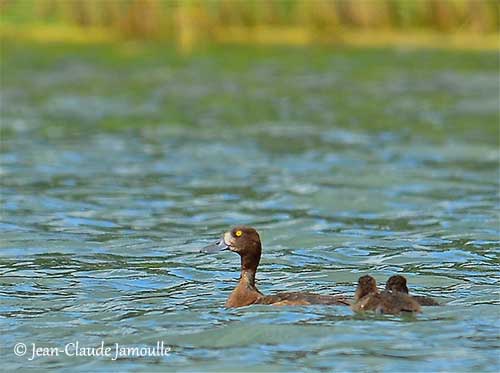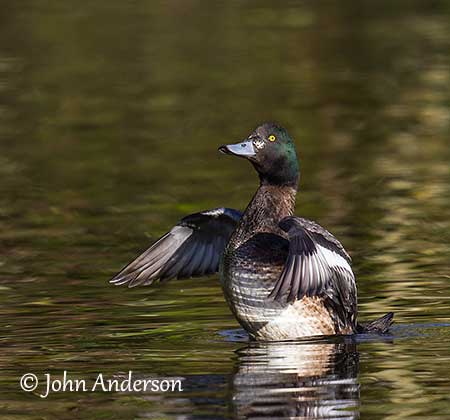
PROTECTION / THREATS / STATUS:
The Greater Scaup is usually common and widespread, but population trends are poorly known.
Some declines throughout the range are probably due to pollution in coastal areas and reduction of food availability. The species is also threatened by fishing nets at sea, and hunting in N America and some European countries.
The global population is estimated to number 1,200,000/1,400,000 individuals (2006). The overall population trend is decreasing or stable, with a significant increase in N America between 1974 and 2011.
The Greater Scaup is currently evaluated as Least Concern.
Fr: Fuligule milouinan
Ang: Greater Scaup
All: Bergente
Esp: Porrón Bastardo
Ita: Moretta grigia
Nd: Topper
Sd: bergand
Photographers:
John Anderson
John Anderson Photo Galleries
Tom Grey
Tom Grey's Bird Pictures & Tom Grey's Bird Pictures 2
Jean-Claude Jamoulle
A la rencontre des Oiseaux
Tom Merigan
Tom Merigan’s Photo Galleries
Otto Plantema
Trips around the world
Text by Nicole Bouglouan
Sources:
HANDBOOK OF THE BIRDS OF THE WORLD vol 1 by Josep del Hoyo-Andrew Elliot-Jordi Sargatal - Lynx Edicions - ISBN: 8487334105
THE COMPLETE BOOK OF BRITISH BIRDS – Written by “Royal Society for the Protection of Birds” experts - Préface de Magnus Magnusson - Michael Cady- Rob Hume Editors - ISBN: 0749509112
THE HANDBOOK OF BIRD IDENTIFICATION FOR EUROPE AND THE WESTERN PALEARCTIC by Mark Beaman, Steve Madge - C. Helm - ISBN: 0713639601
GUIDE DES CANARDS, DES OIES ET DES CYGNES – de Steve Madge - Delachaux et Niestlé - ISBN: 2603013769
ENCYCLOPEDIE DES OISEAUX DE FRANCE ET D’EUROPE – de Peter Hayman et Rob Hume - Flammarion – ISBN : 2082009920
BIRDS OF THE MIDDLE EAST by R.F. Porter, S. Christensen, P Schiermacker-Ansen C.Helm - ISBN: 0713670169
FIELD GUIDE TO THE BIRDS OF NORTH AMERICA - National Geographic Society -ISBN: 0792274512
What Bird-The ultimate Bird Guide (Mitchell Waite)
The Birds of North America online
All About Birds (Cornell Lab of Ornithology)
Wikipedia, the free encyclopaedia
e Nature (National Wildlife Federation)
Greater Scaup
Aythya marila
Anseriformes Order – Anatidae Family
INTRODUCTION:
The Greater Scaup is a fairly large diving duck with bulky appearance, broad bill and rounded crown shape.
This species is chiefly marine in winter, although small groups are regular on large inland lakes. It breeds by freshwater pools, small lakes and rivers in tundra, sometimes at high elevation.
Two subspecies share the wide range. They breed in the northernmost regions of both Old and New Worlds, and winter S along the coasts of both continents.
The Greater Scaup is not currently threatened and the global population is relatively stable.
DESCRIPTION OF THE BIRD:
Biometrics:
Length: 40-51 cm
Wingspan: 72-84 cm
Weight: M: 850-1370 g – F: 700-1310 g
The Greater Scaup adult male in breeding plumage has black head and neck with green or purplish iridescence. Upper mantle, rump and uppertail-coverts are black. Lower mantle, back and scapulars appear pale grey, but at close range, we can see white and black vermiculations, becoming darker on lower back. Body sides and belly are white with indistinct grey vermiculations.
On the upperwing, the coverts are black with brownish tinge and white speckles. We can see a broad, white wingbar over secondaries and most of primaries. The underwing is whitish with dark trailing edge.
The broad bill is pale grey-blue with small black nail. The eyes are golden yellow. Legs and webbed feet are dark slate-blue.
The male in eclipse has similar plumage pattern, but the black parts are browner, and the white body sides are streaked with brown. The bill is duller, and there is sometimes some white at base.
The female is dull brown overall with contrasting white patches surrounding the bill base. She has some white vermiculations on mantle, scapulars and flanks, usually paler than the upperparts. She has browner wings than male.
In worn plumage, she has pale to whitish ear-coverts, often well-visible. The yellow eyes become paler in summer and appear grey sometimes. The bill is greyish-blue. Legs and feet vary from grey-green to dark slate blue.
The juvenile resembles female but it is duller, with less or no white on face and cheeks. It is paler on sides and foreneck, especially in young female. It gains the full adult plumage by the second winter.

SUBSPECIES AND RANGE:
The Greater Scaup has two subspecies.
A.m. marila (described above) breeds in N Eurasia, from Iceland, E to R Lena in Siberia. It winters in NW Europe and around Adriatic, Black and Caspian Seas.
A.m. nearctica breeds in NE Siberia from R Lena, E to Bering Sea coast, Aleutian Islands, and Alaska E through C Canada to Atlantic coast. It winters on Pacific coast of Asia, as far as SE China, and on both coasts of N America S to Baja California and Gulf coasts, and also on Great lakes.
This race is more conspicuously vermiculated black, and has less white on underside of primaries. The dark trailing edge is sharper and broader on primary tips.
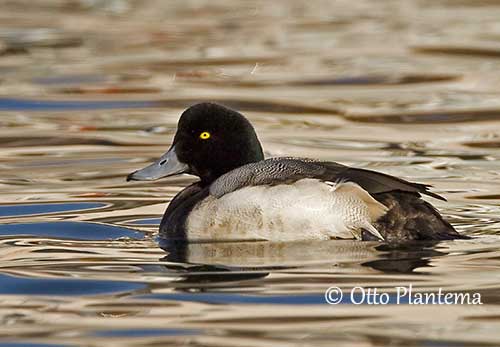
A.m. nearctica
Hokkaido
HABITAT:
The Greater Scaup breeds on freshwater lakes, pools and bogs near the northern edges of boreal forest, and also on tundra. It winters mainly on coastal waters, and can be seen in estuaries, coastal bays and lagoons. Some of them frequent freshwater inland lakes, but this species often prefers more open bays.
CALLS AND SONGS: SOUNDS BY XENO-CANTO
The Greater Scaup is relatively silent outside the breeding season. It utters harsh “karr-karr” in flight. During the displays, the males utter soft cooing and whistling notes. The females give harsh “arr, arr, arr…” typical of genus Aythya but slightly lower.
A.m. nearctica
California
BEHAVIOUR IN THE WILD:
The Greater Scaup feeds on molluscs, insects, crustaceans, worms, small fish and plant material including roots, seeds and green parts of aquatic plants.
During winter, it feeds mainly on mussels, especially the introduced zebra mussel (Dreissena polymorpha) in both Great lakes of N America and parts of Europe, clams, oysters, snails and other molluscs. In summer (and winter on freshwater lakes) it consumes mainly plants, insects and crustaceans.
The Greater Scaup feeds by diving and swimming underwater. It often swallows the prey while swimming, but the larger items are brought to the surface to be eaten. In shallow water, it may sometimes forage by dabbling or upending. This species feeds by day and at night, according to the tides in coastal areas.
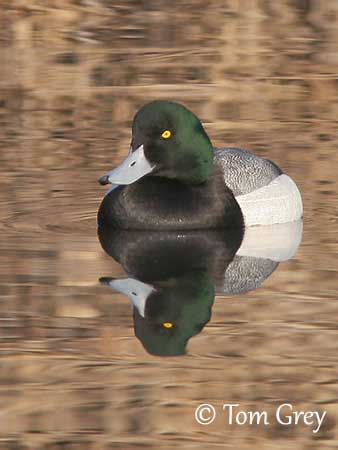
A.m. nearctica
California
The pairs form in late winter and early spring. The male leaves the female during the incubation, and she rears the chicks alone.
During the displays, several males typically court one female. The males throw the head back while uttering a soft call. They also perform exaggerated bowing movements with the bill lowered to water surface, and then, raised upwards. They utter some whistling notes while flicking both wings and tail. The copulation takes place in the water. They are monogamous.
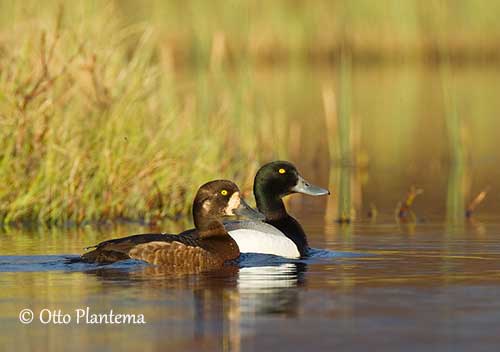
The Greater Scaup is migratory and usually migrates in flocks. Some populations (Iceland and S Norway) tend to remain on the breeding areas or move locally to the coast.
The peak migration occurs between mid to late September in Arctic Russia, and early to late October in E Baltic, Germany, Netherlands and Britain.
They return to N from late February to mid-March. They reach the northernmost breeding areas in late May/early June.
The Greater Scaup flies in flocks but in irregular formations. The flight is strong and direct with powerful, rapid wingbeats.
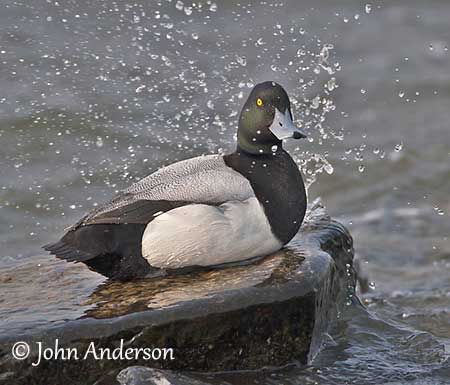
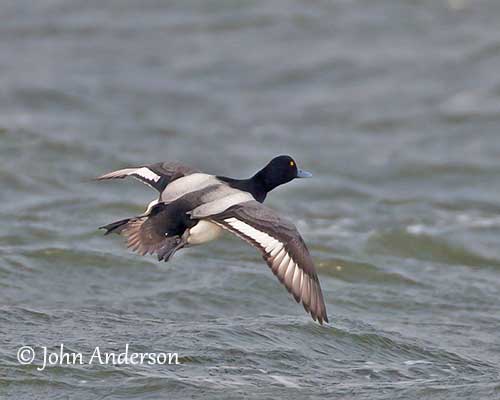
REPRODUCTION OF THIS SPECIES:
The breeding season takes place from May to early June. The Greater Scaup nests in single pairs or in loose groups, sometimes among Laridae colonies.
The female builds the nest on the ground, a depression lined with grass and down, often placed in dense vegetation and sometimes above shallow water on island, shoreline or floating vegetation. Several nests may be close to each other, about 1 metre apart.
A.m. nearctica
California
The female lays 5-11 olive-buff eggs. Larger clutches of more than 15 eggs probably result of 2-3 females laying in the same nest. She incubates during 24-28 days. At hatching, the chicks have chestnut-brown upperparts and yellowish underparts. They leave the nest very soon after hatching and follow the female to the water. They are able to feed themselves. They fledge 40-45 days after hatching.
